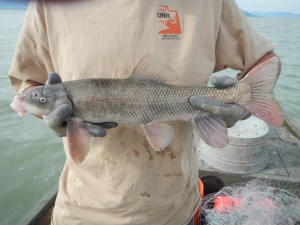
Utah Lake is home to a diverse fish population and is the only place in the world where the endangered June sucker can be found. Last week the Division of Wildlife Resources set fishing nets in Utah Lake as part of an effort to keep the June sucker from becoming extinct.
Over two days biologists measured and released fish caught in several nets placed around the lake. This trap-net survey is an annual activity designed to see how the fish are doing. When they find a June sucker, biologists use special scanners to see if the fish has a tracking ID. If they catch one that doesn’t have an ID, they use a special needle to put one in its stomach.
June suckers are struggling because there are so many carp in the lake. “The carp will uproot vegetation as part of their feeding process,” said Division of Wildlife Resources biologist Dave Tinsley. “They basically turn the lake into a bathtub with no place to hide.” As a result, young June suckers are eaten by bigger fish before they can grow to maturity.
Carp were introduced to Utah Lake in the early 1900s after settlers caught too many June suckers and Bonneville cutthroat trout. Now activists are trying to get the carp out to preserve the June sucker and other fish species.
“So far approximately 18.5 million pounds of carp have been removed from the lake,” said Eric Ellis, executive director of the Utah Lake Commission. “The effort began in 2009 and is forecasted to finish up in the next three years or so.”
Students can do their part to help preserve the June sucker by keeping trash out of the lake and streams. “We were up in the Provo River tributaries and found a mattress there obstructing where these endangered fish go up to spawn,” said Jonah Molina, a DWR employee with a degree in biology. “Just watch your trash and take it with you.”
Activists hope people will notice Division of Wildlife Resources initiatives for the June sucker. “People need to educate themselves and be aware that there is an endangered species essentially living in their backyard,” Tinsley said. ”The June sucker should be a source of pride for the people in our community.”




